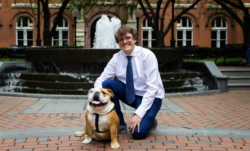Eleven seats were cut from the Georgetown University Student Association Senate on Sunday, September 13 in an effort to improve the efficiency of the organization.
The new system of representation assigns one fewer senator to dormitories and apartment complexes that were previously represented by two students or more. All living areas that had one senator last year still have one seat.
In addition to reducing the number of senators in all but two districts, Reynolds and Kennedy, the senate voted to create four at-large seats not tied to student housing.
Most senators at the meeting voted for the measure, which passed 5-1-1. Normally, the 36-member senate would need 18 senators to be present to meet quorum, but because many senators have graduated or gone abroad, only seven representatives attended the session.
The consensus among the senators present was that having fewer seats in the senate would increase their value to the students who won them.
“When you’re one of 35, you don’t think your voice is very important,” Chris Pigott (COL ‘12) said. “But if I was one of 20, I feel like I would step up and become more involved because there would be no one else to do it.”
Attendance was mentioned at the meeting as a weakness and a strength of the new system. Last year, senate participation routinely clocked in at just over the minimum number of senators required for quorum. Some senators voiced concern that with fewer seats, an even smaller fraction of students would attend.
GUSA President Calen Angert (MSB ‘11) had a different outlook. He compared the new senate to a small class.
“You never want to miss that class, because you know that if you don’t show up, people will know you weren’t there,” Angert said.
GUSA’s executive branch has been atypically involved in the development of the new senate model. An earlier draft of the senate’s redesign, which suggested one senator per residence, was engineered entirely by Vice President Jason Kluger (MSB ‘11).
According to a survey Angert and Kluger put out over the summer, 70 percent of the 898 respondents were in favor of changing the structure of student government.
The one-Senator-per-dorm model was officially proposed by Transition Team leader Nick Troiano (COL ‘11), because Kluger is not a member of the senate. When senators expressed concern over the potential restructuring, Kluger revealed that he created the plan.
His goal was to “make this body more efficient and effective and to gain trust.”
“I wanted to put that first plan out there to spark conversation,” Kluger said. “I’m excited. I think this marks an important shift in GUSA where we’re able to critique ourselves and see where there has been room for improvement.”




